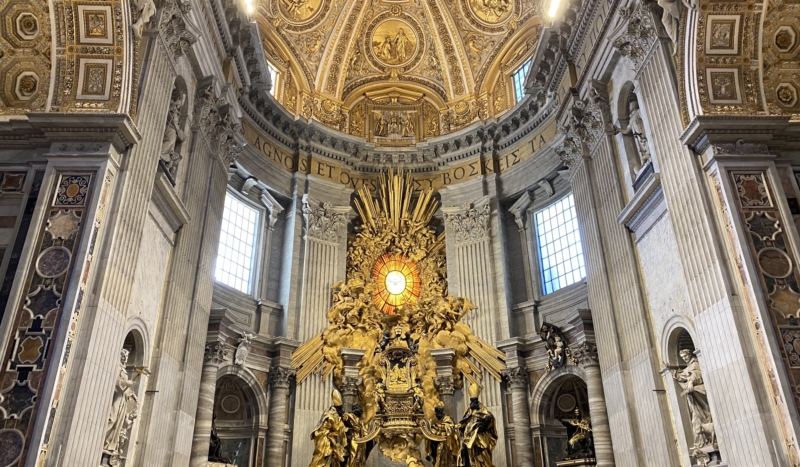
Photo: McKenna Snow / CatholicVote
VATICAN CITY // The Chair of St. Peter holds such profound significance in the life of the Universal Church that it is honored with its own feast day — February 22. Pope Benedict XVI once offered a compelling explanation of its history and spiritual symbolism during a 2006 address on the feast.
The actual chair — considered a second-class relic of the first pope — is preserved in St. Peter’s Basilica. Enshrined in a magnificent sculpture by the 17th-century artist Gian Lorenzo Bernini, the relic is encased in a bronze cathedra (or seat) commissioned by Pope Alexander VII. The dramatic setting includes statues of four great Doctors of the Church: Saints Ambrose, Augustine, Athanasius, and John Chrysostom.
In his catechesis, the pope noted that “cathedra” means the seat of the bishop, and is the origin of the word “cathedral.” The bishop’s seat is a sign of his teaching authority as a successor to the apostles.
The chair “is the symbol of the authority of the bishop and, in particular, of his ‘magisterium,’ that is, of the evangelical teaching that he, insofar as a successor of the apostles, is called to guard and transmit to the Christian community,” Pope Benedict said.
He explained that a bishop guides, teaches, and shepherds his flock from this seat.
“Which was, then, the ‘cathedra’ of St. Peter?” he continued. “He, chosen by Christ as ‘rock’ on which to build the Church, began his ministry in Jerusalem, after the ascension of the Lord and Pentecost. The first ‘seat’ of the Church was the Cenacle, and in all probability in that room, where Mary, the Mother of Jesus, also prayed with the disciples, a special place was reserved for Simon Peter.”
The feast of the Chair of St. Peter dates back to the fourth century and originated from the Roman Martyrology’s commemoration of Peter’s episcopal seat in Antioch, Pope Benedict explained. From there, Peter eventually journeyed to Rome, where he ministered for years before his martyrdom.
“For this reason, the See of Rome, which had received the greatest honor, received also the task entrusted by Christ to Peter of being at the service of all the local Churches for the building and unity of the whole People of God,” he said. “In this way the See of Rome came to be known as that of the Successor of Peter, and the ‘cathedra’ of its Bishop represented that of the apostle charged by Christ to feed all his flock.”
Celebrating the Chair of St. Peter, then, is not merely about a relic or a piece of furniture — it’s about the enduring mission of unity and faithful teaching entrusted to the Pope.
“To celebrate the ‘Chair’ of Peter, as we do today,” he said, “means… to attribute to it a strong spiritual significance and to recognize in it a privileged sign of the love of God, good and eternal Shepherd, who wants to gather the whole of his Church and guide her along the way of salvation.”

